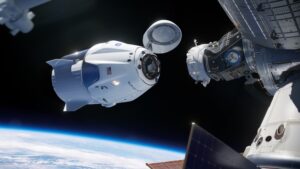NASA warns commercial crew delays create uncertainty in ISS operations

ATLANTA — As NASA praises the increased amount of research being performed on the International Space Station, the station’s manager cautions that uncertainty about commercial crew vehicles may disrupt station operations in the year ahead.
In an opening keynote at the ISS Research and Development Conference here July 30, Kirk Shireman, NASA’s ISS program manager, warned that the upcoming transition to commercial crew vehicles for transporting astronauts to and from the station may create “startup transients” that could disrupt the current smooth pace of operations there.
“There are some great opportunities in our future, but also some challenges, some significant challenges,” Shireman said.
The biggest challenge he cited was the uncertainty of when Boeing’s CST-100 Starliner and SpaceX’s Crew Dragon would be ready to start carrying astronauts. That depends on when the companies are able to complete their test flight program, including both uncrewed and crewed tests of Starliner and an uncrewed in-flight abort test, followed by a crewed test flight, of Crew Dragon.
The uncrewed Starliner test flight is expected no sooner than late September, and more likely October, in part because of delays in the Atlas 5 launch preceding it that is now scheduled for Aug. 8. Meanwhile, a Russian media report July 29 claimed that SpaceX’s crewed test flight, known as Demo-2, was scheduled for Dec. 17, but industry sources believe that is a “no earlier than” date, with the mission likely to slip into 2020.
Shireman said he did not want to rush the companies through their test flights. “We don’t want them to fly until they’re ready to fly,” he said. “Some significant uncertainty remains.”
That uncertainty affects NASA’s planning for crew time, cargo transportation requirements and overall station operations. Shireman said the agency was looking at “multiple options” for those issues depending on when those commercial crew vehicles enter service, but didn’t go into specifics. “We’re trying to be as flexible as we can and maximize the utilization, maximize the support of you, our customers.”
He added he didn’t expect clarity on what option NASA will pursue in the near future. “Unfortunately, for the next few months I don’t believe we’ll be able to remove that uncertainty,” he said, offering to provide regular updates on the status of station operations and be flexible.
Another factor affecting utilization is spacewalks. “Over the next 12 months we have an unprecedented number of spacewalks, and an unprecedented complexity of spacewalks,” he said. That includes several to continue replacing batteries in the station’s power system as well as repairs of the Alpha Magnetic Spectrometer (AMS) instrument, which was not never designed for servicing in orbit. “These will be the most challenging EVAs ever conducted,” he said of the AMS repairs.
Those issues are likely to eat into research time on the station in the coming months. Shireman noted in the last year NASA set records three times in the number of crew hours per week devoted to research.
“This is a transition,” he said of the shift from relying on Soyuz vehicles to transport astronauts to and from the station to the new commercial crew vehicles. “There are startup transients. That’s what we’ll experience this year. But it’s transient. I expect in the very near future we’ll be having regular service, regular crews flying exactly when we expect them to fly. We’ll be back in a normal cadence with very little uncertainty.”
from SpaceNews.com https://ift.tt/2Kitczh
Comments
Post a Comment